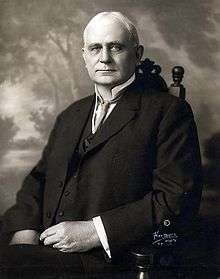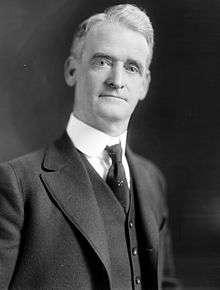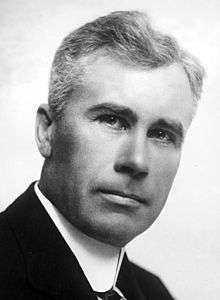United States House of Representatives elections, 1916
| | |||||||||||||||||||||||||||||||||||||||||||||||||||||||||||||||||||||||
| |||||||||||||||||||||||||||||||||||||||||||||||||||||||||||||||||||||||
| |||||||||||||||||||||||||||||||||||||||||||||||||||||||||||||||||||||||
| |||||||||||||||||||||||||||||||||||||||||||||||||||||||||||||||||||||||
Elections to the United States House of Representatives in 1916 were held for members of the 65th Congress, coinciding with the re-election of President Woodrow Wilson.
Wilson eked out a narrow re-election, but his Democratic Party lost seats to the opposition Republican Party. Wilson's hybrid approach, which injected a progressive element into Democratic policies, had proved to be dissatisfying to much of the nation. International affairs also became important in the traditionally non-interventionist United States, as voters attempted to determine which party would be best served to keep the nation from entering The Great War.
Although the Republicans gained a plurality, the Democrats narrowly maintained control of the House with minor party support, forming an alliance with the remaining third-party Progressives and Socialist Meyer London. This is the last example (to date) of a type of coalition holding power in the House, rather than a single party winning a majority of seats. Specifically, this is also the only election in U.S. history when three different parties were able to form a coalition government instead of just two. Because of this, it was only the second Congress where the party with the most seats was in opposition (versus being part of the ruling government) in the House, the first being the 34th Congress elected in 1854. This rare occurrence may have been why the parties' plan to form a coalition backfired, as voters quickly rejected the Progressive and Socialist parties in the next election. Meanwhile, the Democrats also lost support afterwards and would not control the House again until after the 1930 elections.
Jeannette Rankin, a Republican from Montana was the first woman ever elected to congress.
Election summaries
| 214 | 1 | 3 | 1 | 216 |
| Democratic | S | P | Pn | Republican |
| State | Type | Total seats |
Republican | Democratic | Progressive | Others | ||||
|---|---|---|---|---|---|---|---|---|---|---|
| Seats | Change | Seats | Change | Seats | Change | Seats | Change | |||
| Alabama | District[Note 4] | 10 | 0 | |
10 | |
0 | |
0 | |
| Arizona | At-large | 1 | 0 | |
1 | |
0 | |
0 | |
| Arkansas | District | 7 | 0 | |
7 | |
0 | |
0 | |
| California | District | 11 | 5 | |
4 | |
1 | |
1[Note 5] | |
| Colorado | District | 4 | 1 | |
3 | |
0 | |
0 | |
| Connecticut | District | 5 | 4 | |
1 | |
0 | |
0 | |
| Delaware | At-large | 1 | 0 | |
1 | |
0 | |
0 | |
| Florida | District | 4 | 0 | |
4 | |
0 | |
0 | |
| Georgia | District | 12 | 0 | |
12 | |
0 | |
0 | |
| Idaho | At-large | 2 | 2 | |
0 | |
0 | |
0 | |
| Illinois | District +2 at-large |
27 | 21 | |
6 | |
0 | |
0 | |
| Indiana | District | 13 | 9 | |
4 | |
0 | |
0 | |
| Iowa | District | 11 | 11 | |
0 | |
0 | |
0 | |
| Kansas | District | 8 | 3 | |
5 | |
0 | |
0 | |
| Kentucky | District | 11 | 2 | |
9 | |
0 | |
0 | |
| Louisiana | District | 8 | 0 | |
7 | |
1 | |
0 | |
| Maine[Note 6] | District | 4 | 4 | |
0 | |
0 | |
0 | |
| Maryland | District | 6 | 2 | |
4 | |
0 | |
0 | |
| Massachusetts | District | 16 | 12 | |
4 | |
0 | |
0 | |
| Michigan | District | 13 | 12 | |
1 | |
0 | |
0 | |
| Minnesota | District | 10 | 9 | |
1 | |
0 | |
0 | |
| Mississippi | District | 8 | 0 | |
8 | |
0 | |
0 | |
| Missouri | District | 16 | 2 | |
14 | |
0 | |
0 | |
| Montana | At-large | 2 | 1 | |
1 | |
0 | |
0 | |
| Nebraska | District | 6 | 3 | |
3 | |
0 | |
0 | |
| Nevada | At-large | 1 | 1 | |
0 | |
0 | |
0 | |
| New Hampshire | District | 2 | 2 | |
0 | |
0 | |
0 | |
| New Jersey | District | 12 | 9 | |
3 | |
0 | |
0 | |
| New Mexico | At-large | 1 | 0 | |
1 | |
0 | |
0 | |
| New York | District | 43 | 26 | |
16 | |
0 | |
1[Note 7] | |
| North Carolina | District | 10 | 0 | |
10 | |
0 | |
0 | |
| North Dakota | District | 3 | 3 | |
0 | |
0 | |
0 | |
| Ohio | District | 22 | 9 | |
13 | |
0 | |
0 | |
| Oklahoma | District | 8 | 2 | |
6 | |
0 | |
0 | |
| Oregon | District | 3 | 3 | |
0 | |
0 | |
0 | |
| Pennsylvania | District +4 at-large |
36 | 29 | |
6 | |
1 | |
0 | |
| Rhode Island | District | 3 | 2 | |
1 | |
0 | |
0 | |
| South Carolina | District | 7 | 0 | |
7 | |
0 | |
0 | |
| South Dakota | District | 3 | 2 | |
1 | |
0 | |
0 | |
| Tennessee | District | 10 | 2 | |
8 | |
0 | |
0 | |
| Texas | District +2 at-large |
18 | 0 | |
18 | |
0 | |
0 | |
| Utah | District | 2 | 0 | |
2 | |
0 | |
0 | |
| Vermont | District | 2 | 2 | |
0 | |
0 | |
0 | |
| Virginia | District | 10 | 1 | |
9 | |
0 | |
0 | |
| Washington | District | 5 | 4 | |
1 | |
0 | |
0 | |
| West Virginia | District[Note 4] | 6 | 4 | |
2 | |
0 | |
0 | |
| Wisconsin | District | 11 | 11 | |
0 | |
0 | |
0 | |
| Wyoming | At-large | 1 | 1 | |
0 | |
0 | |
0 | |
| Total | 435 | 216[Note 2] 49.7% |
|
214 49.2% |
|
3 0.7% |
|
2[Note 8] 0.5% |
| |
The Democrats retained control of the House by forming a coalition with the three Progressive members and the single Socialist member, combining to form a razor-thin majority of 218 Representatives.
[[Image:65 us house membership.png|thumb|450px|
]] |
[[Image:65 us house changes.png|thumb|450px|
]] | |||||||||||||||||||||||
Early election date
Maine held its election early, on September 11, 1916. There had previously been multiple states with earlier elections, but between 1914 and 1958, Maine was alone in holding early elections.
Complete results
Party abbreviations
- D: Democratic
- I: Independent
- Prog: Progressive
- Proh: Prohibition
- R: Republican
- S: Socialist
A slash between two labels indicates a fusion ticket
California
| District | Incumbent | Party | First elected |
Result | Candidates |
|---|---|---|---|---|---|
| California 1 | William Kent | Independent | 1910 | Retired Democratic gain |
Clarence F. Lea (D) 48.8% Edward H. Hart (R) 42.8% Mary M. Morgan (S) 5.5% Jay Scott Ryder (Proh) 2.9% |
| California 2 | John E. Raker | Democratic | 1910 | Re-elected | John E. Raker (D) 71% James T. Matlock (R) 29% |
| California 3 | Charles F. Curry | Republican | 1912 | Re-elected | Charles F. Curry (R) 66.7% O. W. Kennedy (D) 23.4% Ben Cooper (S) 6.2% Edwin F. Van Vlear (Proh) 3.7% |
| California 4 | Julius Kahn | Republican | 1898 | Re-elected | Julius Kahn (R) 77.2% J. M. Fernald (D) 15.7% Allen K. Gifford (S) 5.6% Henry W. Hutchinson (Proh) 1.5% |
| California 5 | John I. Nolan | Republican | 1912 | Re-elected | John I. Nolan (R) 84.7% Charles A. Preston (S) 9.6% Frederick Head (Proh) 5.8% |
| California 6 | John A. Elston | Progressive | 1912 | Re-elected | John A. Elston (Prog) 64.6% H. Avery Whitney (D) 22.6% Luella Twining (S) 8.7% Harlow E. Wolcott (Proh) 4.1% |
| California 7 | Denver S. Church | Democratic | 1912 | Re-elected | Denver S. Church (D) 51% W. W. Phillips (R) 36.4% Harry M. McKee (S) 7.2% J. F. Butler (Proh) 5.3% |
| California 8 | Everis A. Hayes | Republican | 1904 | Re-elected | Everis A. Hayes (R) 68.6% George S. Walker (Prog/D) 23.8% Cora Pattleton Wilson (S) 7.5% |
| California 9 | Charles H. Randall | Prohibition | 1914 | Re-elected | Charles H. Randall (Proh.) 57.8% Charles W. Bell (I) 32.7% Ralph L. Criswell (S) 9.5% |
| California 10 | Henry S. Benedict | Progressive | 1916 | Retired Republican gain |
Henry Z. Osborne (R) 49.5% Rufus V. Bowden (D) 25.7% Henry Stanley Benedict (Prog) 11.1% James H. Ryckman (S) 7% Henry Clay Needham (Proh) 6.8% |
| California 11 | William Kettner | Democratic | 1912 | Re-elected | William Kettner (D) 44.5% Robert C. Harbison (R) 35.7% James S. Edwards (Proh) 15.6% Marcus W. Robbins (S) 4.1% |
Montana
This was the last time Montana used an at-large district until its representation was reduced to one in 1992. This was also the first time a woman was elected to Congress.
| District | Incumbent | Party | First elected |
Result | Candidates |
|---|---|---|---|---|---|
| Montana at-large 2 seats on a general ticket |
John M. Evans | Democratic | 1912 | Re-elected | John M. Evans (D) 26.7% Jeannette Rankin (R) 24.3% Harry B. Mitchell (D) 22.3% George W. Farr (R) 21.2% John McGuffey (S) 2.8% Albert F. Meissner (S) 2.7% |
| Tom Stout | Democratic | 1912 | Retired Republican gain |
South Carolina
| District | Incumbent | Party | First elected |
Result | Candidates |
|---|---|---|---|---|---|
| South Carolina 1 | Richard S. Whaley | Democratic | 1913 (special) | Re-elected | Richard S. Whaley (D) 95.4% J. O. Ladd (R) 4.6% |
| South Carolina 2 | James F. Byrnes | Democratic | 1910 | Re-elected | James F. Byrnes (D) 98.5% Isaac Myers (R) 1.5% |
| South Carolina 3 | Wyatt Aiken | Democratic | 1902 | Lost primary Democratic hold |
Frederick H. Dominick (D) 100% |
| South Carolina 4 | Samuel J. Nicholls | Democratic | 1915 (special) | Re-elected | Samuel J. Nicholls (D) 99.4% G. F. Mills (R) 0.6% |
| South Carolina 5 | David E. Finley | Democratic | 1898 | Re-elected | David E. Finley (D) 100% |
| South Carolina 6 | J. Willard Ragsdale | Democratic | 1912 | Re-elected | J. Willard Ragsdale (D) 99.1% W. L. McFarlan (R) 0.9% |
| South Carolina 7 | Asbury F. Lever | Democratic | 1901 (special) | Re-elected | Asbury F. Lever (D) 93.5% I. S. Leevy (R) 6.5% |
See also
Notes
- ↑ Maine held early elections on September 11, 1916.
- 1 2 Includes 1 Independent Republican.
- ↑ Democrats maintained control of the U.S. House after the 1916 elections by forming a 218-member coalition with the three Progressive members and the one Socialist member.
- 1 2 At-large seat eliminated in redistricting.
- ↑ Prohibition
- ↑ Elections held early.
- ↑ Socialist
- ↑ 1 Socialist and 1 Prohibition.
Bibliography
- Dubin, Michael J. (March 1, 1998). United States Congressional Elections, 1788-1997: The Official Results of the Elections of the 1st Through 105th Congresses. McFarland and Company. ISBN 978-0786402830.
- Martis, Kenneth C. (January 1, 1989). The Historical Atlas of Political Parties in the United States Congress, 1789-1989. Macmillan Publishing Company. ISBN 978-0029201701.
- Moore, John L., ed. (1994). Congressional Quarterly's Guide to U.S. Elections (Third ed.). Congressional Quarterly Inc. ISBN 978-0871879967.
- "Party Divisions of the House of Representatives* 1789–Present". Office of the Historian, House of United States House of Representatives. Retrieved January 21, 2015.
External links
- Office of the Historian (Office of Art & Archives, Office of the Clerk, U.S. House of Representatives)




